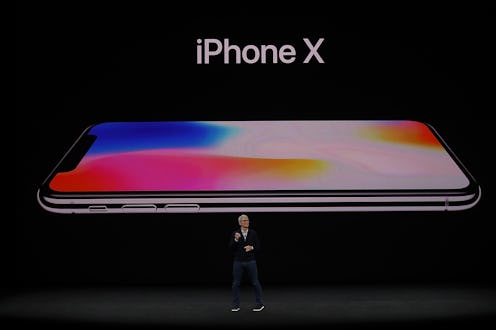News
The iPhone X Has The Biggest Screen Yet

On Tuesday, after weeks of leaks and rumors, Apple finally unveiled its new line of phones. As anticipated, the new product line consists of three devices: the iPhone 8, the iPhone 8 Plus and, most interestingly, the iPhone X. The latter will be the company's premium model iPhone, with a higher price and more advanced features than the 8 and 8 Plus. If you're wondering how big the iPhone X will be, you'll be happy to know it has the biggest display of any Apple phone.
At 5.8 inches, the iPhone X will have a bigger screen than than even the previous iPhone Plus models. But it's not just the size that differentiates the iPhone X's screen from those of the 8 and 8 Plus.
The first iPhone was released 10 years ago (hence the "X" in "iPhone X"), and subsequent models' screens have gradually grown since then. The original iPhone had a wee 3.5-inch display, and it remained that size until the iPhone 5, which upped the display size to 4 inches. The iPhone 6 added an extra .7 inches to the 5's screen, while the 6 Plus was the first to carry a massive 5.5-inch screen.
The iPhone X will be bigger still, with a 5.8-inch display. That'll no doubt be a draw for customers who use their phones for high-end multimedia purposes, such as watching films or editing photos and video. But the technology behind the iPhone X's display may end up being more significant than the size of the screen itself.
Every iPhone model up until the X utilized LCD technology for its screens, but the X instead has an OLED display. The biggest difference between the two types of technologies is that an LCD requires a separate backlight behind the screen to illuminate the display, while OLED has its own illumination built into every individual pixel on the screen. As a result, OLED screens use far less power than LCDs, since they don't have an additional light behind the screen to suck up energy. This means that the iPhone X will be much more energy efficient than all previous models, as illuminating the screen is traditionally the biggest drain on a smartphone's battery, according to MacWorld.
There are more differences as well. The lack of an additional backlight allows OLED screens to be thinner than their LCD counterparts (which of course makes the phone itself thinner), and OLED displays have brighter, more vibrant colors than LCD. OLED technology is expensive, however: According to TechCrunch, an LCD iPhone display costs Apple around $50 to make, while the manufacturing cost for each OLED screen runs $125. That's one big reason why the iPhone X will cost up to $1,149 compared with at least $699 and at least $799 for the iPhone 8 and 8 Plus, respectively.
Although the X's 5.8-inch screen will be the biggest yet for an iPhone, not all users have been thrilled with the phone's steadily-expanding display size. Apple has continually released smaller-size models to please consumers even as the main product line's screens have been growing: In 2016, two years after the release of the 5.5-inch iPhone 6 Plus, Apple put out the iPhone SE, which carried a classic 4-inch screen.
The iPhone X has a slew of other new features aside from its big screen. It will sport facial recognition technology, allowing users to unlock their phones simply by moving their faces around in front of the camera, which will supposedly have better depth perception than its predecessors. The phone will run on the new iOS 11 operating system, which has cool new features like animated emojis (or "animojis") and additional shortcuts for the phone's physical buttons.